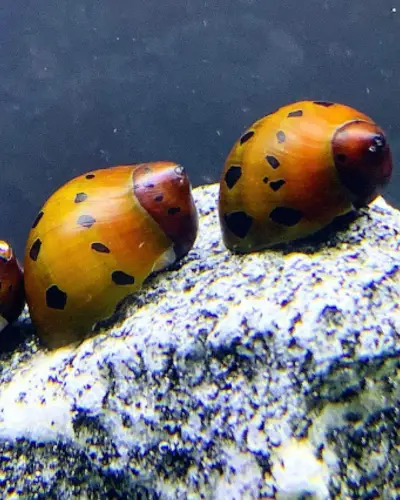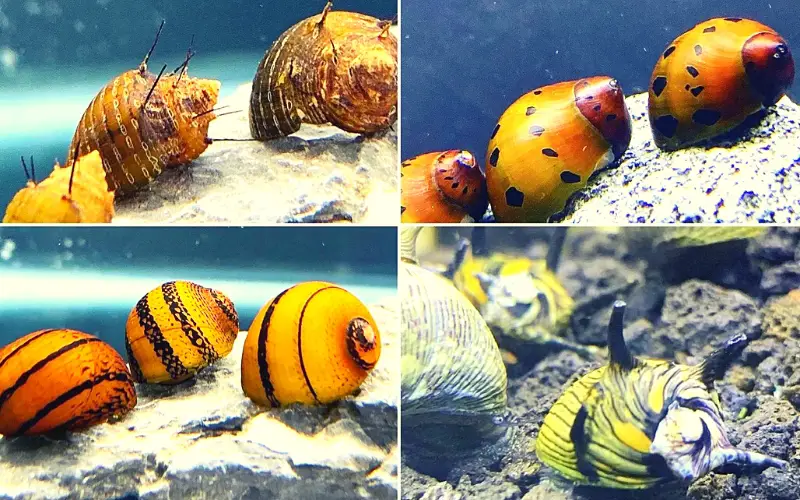The Tiger Nerite Snail, also known as the Tiger Snail or Neritina Natalensis, is a popular choice for freshwater aquariums due to its striking appearance and efficient algae-eating abilities.
With its unique patterned shell and peaceful nature, the Tiger Eye Nerite Snail can make a beautiful and functional addition to any tank.
However, caring for these snails requires specific knowledge and attention to their needs to ensure their health and longevity in captivity.

This comprehensive care guide will provide all the information you need to care for your Nerite tiger snail in your aquarium successfully.
From water parameters and diet to tank mates and breeding, we will cover everything you need to know to create the perfect environment for these fascinating creatures.
Whether you are a beginner or experienced aquarist, this guide will serve as your ultimate resource for caring for Tiger Nerite Snails, providing you with the only care guide you’ll ever need.
Table of Contents
ToggleTiger Nerite Snails Overview:
Tiger Eye Nerite snails are one of the most popular aquatic invertebrate species among aquarium hobbyists. They are hardy and can thrive in a variety of water conditions, including freshwater and saltwater, as well as salty water.
These snails are known for their ability to help keep a tank clean by consuming algae wafers and other types of algae. They also lay eggs on hard surfaces such as aquarium plants and driftwood, although they will not hatch in freshwater.

They come in different varieties, such as the olive nerite snail and the black racer, and are typically the size of a quarter. Nerite snails require a stable water temperature and a diet rich in calcium to thrive.
They are also compatible with a wide range of tank mates, including shrimp, loach, and cichlids, making them a great addition to a community tank.
How to Set Up an Aquarium for Nerite Snails
Setting up an aquarium for nerite snails is pretty straightforward, but there are some key things to keep in mind to ensure they thrive. Here’s a breakdown:
Tank Size and Water Parameters:
- Size: Nerite snails can do well in small tanks, starting from 2-3 gallons for a single snail. For multiple snails, increase the length by 5 gallons per additional snail.
- Water:pH: Nerites prefer slightly higher pH levels (7.0 to 8.5) compared to some other freshwater fish.
- GH/KH: Aim for water hardness in the range of 12-18 for both general hardness (GH) and carbonate hardness (KH). This ensures sufficient minerals for their shell health.
- Temperature: They are adaptable to a wide range (65-85°F), but tropical temperatures (75-82°F) are ideal.
Habitat:
- Substrate: Opt for a sand or gravel substrate, as it’s easier for them to navigate. Crushed coral can help raise pH and KH naturally.
- Decorations: Provide plenty of hiding places like rocks, driftwood, and caves. They also need surfaces to graze on, so include plants, smooth stones, and other decorations.
- Lid: They might try to escape, so ensure the tank has a secure lid with enough clearance for air exchange.
Food and Care:
- Algae: Nerites primarily eat algae, making them excellent tank cleaners. However, supplement their diet with algae wafers, blanched vegetables like kale or zucchini, or calcium-rich food blocks.
- Water changes: Perform regular water changes (10-20% weekly) to maintain good water quality.
- Calcium source: If your water hardness is low, provide additional calcium using cuttlebone, crushed coral, or calcium supplements.
Additional Tips:
- Avoid copper-based medications, as they are toxic to snails.
- Monitor for cracked or eroded shells, which can indicate calcium deficiency.
- While they may lay eggs, these won’t hatch in freshwater. So, don’t worry about snail population explosions.
By following these steps and providing a healthy environment, your nerite snails will thrive and keep your tank algae-free!
Tiger Nerite Snail Caring Tips
Tiger Nerite Snails, require freshwater and are sensitive to copper, making them safe to keep with other peaceful tank mates.
One caring tip for Tiger Nerite snails is to ensure enough algae in the tank for them to feed on, such as green spot algae. Additionally, they like live plants in their environment and can be housed in an established planted aquarium.
When it comes to breeding Nerite tiger snails, they require brackish water to reproduce, so if you have a saltwater tank, you may be able to breed these snails.
If you find nerite snail eggs throughout the tank, you can remove it from the tank if you do not want them to breed. With proper care, Tiger Nerite snails can be a valuable part of your aquarium cleanup crew.
Recommended Tank Parameters for Tiger Nerite Snails
Here are the recommended tank parameters for Tiger Nerite Snails:
- Temperature: 65° to 85° F (18° to 29° C)
- pH: 6.5 to 8.5
- KH: 5 – 12 dKH
- GH: 12-18 dGH
- Minimum tank size: 2 gallons per snail
Tiger Nerite Snails are relatively easy to care for, but ensuring their tank parameters are within the recommended range is essential.
They are sensitive to high levels of copper, so be sure to use a dechlorinator that removes copper from your tap water. They are also escape artists, so make sure your tank has a tight-fitting lid.
With proper care, Tiger Eye Nerite Snails can live for several years. They are a great addition to any freshwater aquarium and can help to keep the tank clean and free of algae.
Tiger Nerite Snails Algae Eating: Diet, & Food Sources
Nerite Tiger Snails are a species of Neritidae, a type of freshwater snail popular among aquarium hobby enthusiasts for their ability to consume large amounts of algae. These small-sized snails have a zebra-like stripe pattern on their shells, lending them their “tiger” moniker.
They are best kept in a planted tank with a steady supply of algae for them to feed on. In the absence of algae, they can be fed fish food or algae wafers.
Their adaptability to various conditions makes them suitable for fresh water aquariums. They are among the best algae-eating freshwater snails available, and their ability to thrive in conditions with high levels of nitrate makes them valuable for maintaining water quality.
Some nerite snails may require salt in their water throughout their lives, while others can thrive without it. However, they are not likely to overpopulate an aquarium, as their larva require a marine species of water to develop.
The snails have a reputation for being unable to reproduce in freshwater aquariums, making them a low-risk choice for algae control. Their ability to withstand aquarium temperature around 78 degrees Fahrenheit also makes them a favorite among aquarium hobby enthusiasts.
Tiger Eye Nerite Snail Lifespan, Tank Size, Color & Tank Mates
Sure, here is some information about Tiger Eye Nerite Snails:
- Lifespan: 3-5 years
- Tank size: 10 gallons or more
- Color: Olive green with black stripes, resembling a tiger’s eye gemstone
- Tank mates: Peaceful fish, shrimp, and plants
Tiger Eye Nerite Snails are a popular choice for freshwater aquariums because they are beautiful, easy to care for and help to keep the tank clean by eating algae. They are peaceful creatures that will not bother other tank inhabitants.
Types Of Nerite Snails For Freshwater Tanks
There are several species of nerite snails available for freshwater tanks, each with its unique characteristics. One of the most popular types is the zebra nerite snail, known for its small size and striking black and yellow striped pattern reminiscent of its namesake, the Greek sea god.
These snails are excellent at keeping tanks clean as they feed on algae and are peaceful tankmates for fish like Corydoras and shrimp.
They are also adaptable to various water conditions and are not prone to overpopulating the tank. Another popular species is the tiger nerite snail, with its intricate pattern resembling a tiger’s stripes.
Like their zebra counterparts, these snails are excellent at consuming algae and are resistant to most fish medications like copper and other medications. However, it’s worth noting that they require a breeding tank with brackish water to successfully breed nerite snails.
Commonly Asked Questions about Tiger Nerite Snail Care in Freshwater Aquariums (FAQs)
How big does a Tiger Nerite snail get?
Tiger Nerite snails typically reach 1 inch, with some reaching 1.5 inches. They won’t outgrow your tank and focus on algae, not plants, making them great tank additions!
How long do tiger nerite snail live?
What is a freshwater tiger nerite snails lifespan? Tiger Nerites enjoy a lifespan of 1-2 years, keeping your tank sparkling clean of algae while they cruise! Some lucky snails might even live longer.
How to breed tiger nerite snails?
Unfortunately, breeding Tiger Nerite snails in freshwater isn’t possible! They require brackish water (mix of fresh & saltwater) for successful breeding. Consider other peaceful algae eaters for your freshwater tank.
What do tiger nerite snails eat?
What does a tiger nerite snail eat? Tiger Nerite snails are algae gobbling machines! They munch on various algae, leftover food, and even blanched veggies if algae run low. Keep your tank sparkling clean with these helpful herbivores!
What is the difference between a tiger Nerite and a zebra Nerite?
What is the difference between zebra and tiger Nerite? Spot the stripes! Zebra Nerites have bold black & gold stripes, while Tiger Nerites sport orange shells dotted with black spots. Both are algae-eating champs, adding beauty and cleanup to your tank!
Do Tiger Nerite snails reproduce?
Tiger Eye Nerite snails won’t multiply in freshwater tanks! They need special “brackish” water (mix of fresh & saltwater) to breed. Enjoy their algae control without worrying about overpopulation!
Are Zebra Nerite snails good?
Zebra Nerites are aquarium rockstars! They devour algae, are safe for plants & fish, and stay a manageable size. Their stunning stripes are a bonus! Consider them for a cleaner, more beautiful tank.
Conclusion
Tiger nerite snails are a great addition to any freshwater aquarium. Their unique appearance with black and orange stripes adds visual interest to the tank. These snails are also efficient algae eaters, making them beneficial for keeping the tank clean. With their spike-shaped shells, they are less likely to be preyed upon by larger fish, making them a safer option for smaller tanks.
Additionally, tiger nerite snails are sensitive to ammonia levels, so their presence can also serve as an indicator of water quality. When it comes to controlling algae in the tank, tiger nerite snails are among the best algae eaters, outperforming other popular options such as horned nerite snails, ramshorn snails, and mystery snails. When maintained in water with a pH around 7.5, tiger nerite snails are likely to thrive and contribute to the overall health of the aquarium ecosystem.
You might also like
- Black Racer Nerite Snail 101: Comprehensive Beginners Guide!
- Nerite Snails Water Parameters: (Experts Care & Tank Set Up)
- Nerite Snails Size 101: (Expert Care Guide & Tank Set Up)
- The Best Zebra Nerite Snail Temperature (Expert Care Guide)
- Different Nerite Snails Types: (Your Aquatic Companion)
- Red Racer Nerite Snail Care 101:( A Comprehensive Guide)
- King Koopa Nerite Snail Care 101: Your Aquatic Garden’s New Star!
- Zebra Snail 101: The Ultimate Beginners Care Guide




